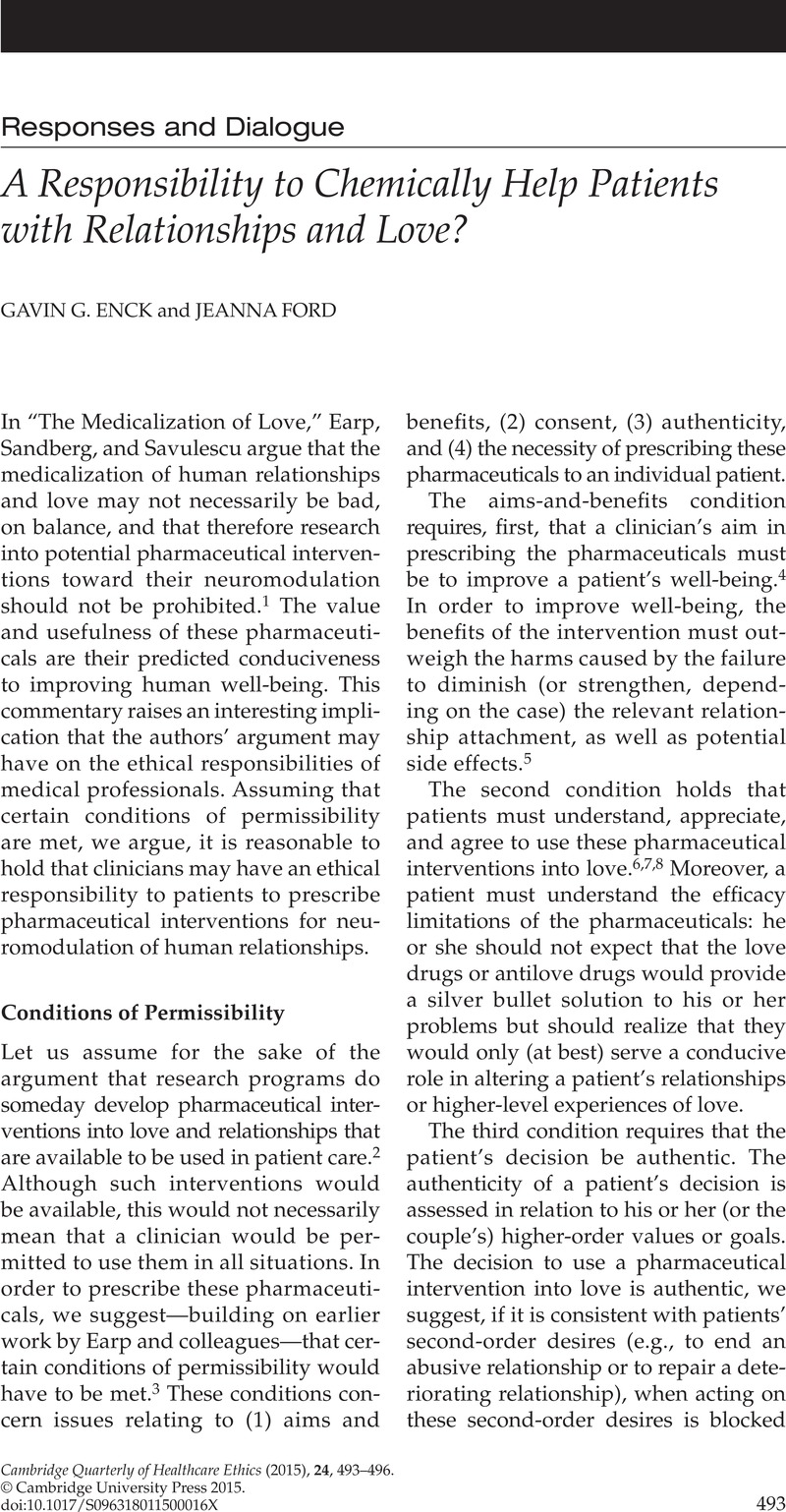Article contents
A Responsibility to Chemically Help Patients with Relationships and Love?
Published online by Cambridge University Press: 14 September 2015
Abstract

- Type
- Departments and Columns
- Information
- Copyright
- Copyright © Cambridge University Press 2015
References
Notes
1. Earp, BD, Sandberg, A, Savulescu, J. The medicalization of love. Cambridge Quarterly of Healthcare Ethics 2015;24:323–36.CrossRefGoogle ScholarPubMed
2. This assumption of being available for use in patient care means that these pharmaceutical interventions into love will have passed the requisite safety trials and measures. We would caution, however, that nearly all psychotropic pharmaceuticals have side effects and that efficacy is often hard to establish. Moreover, as Terbeck and Chesterman argued recently, the sheer complexity of human neurology and high-order brain functions means that there will likely never be a psychotropic pharmaceutical that does not have side effects; hence it would be important to determine that the risk of these side effects was outweighed by the benefits of the intervention. See Terbeck, S, Chesterman, LP. Will there ever be a drug with no or negligible side effects? Evidence from neuroscience. Neuroethics 2014;7(2):89–194.CrossRefGoogle Scholar
3. Earp, BD, Wudarczyk, OA, Sandberg, A, Savulescu, J. If I could just stop loving you: Anti-love biotechnology and the ethics of a chemical breakup. American Journal of Bioethics 2013:3–17.CrossRefGoogle Scholar
4. Earp, Sandberg, and Savulescu offer empirical evidence indicating the profound effect relationships and love have on human well-being.
5. See note 3, Earp et al. 2013.
6. Appelbaum, PS. Assessment of patients’ competence. New England Journal of Medicine 2007;357(18):1834–40.CrossRefGoogle ScholarPubMed
7. Beauchamp, TL, Childress, JS. Principles of Biomedical Ethics. 7th ed. Oxford: Oxford University Press; 2012.Google Scholar
8. Jonsen, AR, Siegler, M, Winslade, WJ. Clinical Ethics: A Practical Approach to Ethical Decisions in Clinical Medicine. 7th ed.New York: McGraw-Hill Medical; 2010.Google Scholar
9. See note 3, Earp et al. 2013.
10. See note 3, Earp et al. 2013, for further discussion.
11. Cassell, EJ. The Nature of Healing: The Modern Practice of Medicine. Oxford: Oxford University Press; 2012.CrossRefGoogle Scholar
12. Pellegrino, ED. Toward a reconstruction of medical morality. American Journal of Bioethics 2006;6(2):65–71.CrossRefGoogle Scholar
13. Although the process of healing aims to improve patient well-being, it does not follow that a patient’s view of what is necessary to improve well-being is appropriate or feasible in all situations or that the use of treatments and interventions always improves patient well-being.
14. White, DB, Jonsen, AR, Lo, B. Ethical challenge: When clinicians act as surrogates for unrepresented patients. American Journal of Critical Care 2012;21(3):202–7.CrossRefGoogle ScholarPubMed
15. Enck, GG. Pharmaceutical enhancement and medical professionals. Medicine, Healthcare and Philosophy 2014;17(1):23–8.CrossRefGoogle ScholarPubMed
16. Enck, GG. Pharmaceutically enhancing medical professionals for difficult conversations. Journal of Evolution and Technology 2013;23(1):45–55.Google Scholar
17. Traupmann, J, Hatfield, E. Love and its effect on mental and physical health. In: Fogel, R, Hatfield, E, Kiesler, S, Shanas, E, eds. Aging: Stability and Change in the Family. New York: Academic Press; 1981:253–74.Google Scholar
18. Pienta, AM, Hayward, MD, Jenkins, KR. Health consequences of marriage for the retirement years. Journal of Family Issues 2000;21:559–86.CrossRefGoogle Scholar
19. Holt-Lunstad, J, Smith, TB, Layton, JB. Social relationships and mortality risk: A meta-analytic review. PLoS Medicine 2010;7(7), e1000316:20.CrossRefGoogle ScholarPubMed
20. Jaremka, LM, Fagundes, CP, Peng, J. Loneliness promotes inflammation during acute stress. Psychological Science 2013 (Early Access):1–9.Google ScholarPubMed
21. Wilson, C, Oswald, AJ. How does marriage affect physical and psychological health? A survey of the longitudinal evidence. IZA Discussion Paper 2005;1619:1–30.Google Scholar
- 1
- Cited by


